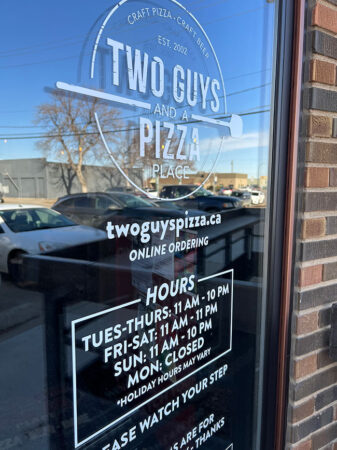
Hour struggle
By Andrew Hind
Features Business and Operations StaffingLabour shortages and risk of burnout causing pizzerias to curtail operations
 Photo: Iryna Adobe Stock
Photo: Iryna Adobe Stock In 2023, the restaurant industry is experiencing an unprecedented labour shortage, forcing many businesses to curtail operations as they struggle to find enough staff.
Navigating this labour shortage is, at the moment, one of the most challenging aspects of pizzeria and restaurant operations.
The cause
We all know the impact COVID-19 had on the restaurant industry. Shuttered restaurants. Reduced capacities. Numerous restrictions aimed at curbing the spread of the virus. Laid-off staff.
But even after dining restrictions were lifted across the country and restaurants began hanging out the “Now Hiring” signs, a substantial number of former restaurant workers (as many as one-third, according to some estimates) decided not to return to the hospitality industry. The question is why, and where did they go?
Working in the restaurant industry at the height of the pandemic was fraught with stress, uncertainty and fear. Lost wages during public health-mandated closures, and lower wages because of reduced hours and lack of tips when restaurants reopened at reduced capacity, called into question one’s ability to make a living. Pair this with fear of working in a high-risk setting – food-service workers had some of the highest mortality rates during the pandemic – and it’s little wonder that few workers looked on a career in the restaurant industry favorably.
In truth, the pandemic hardships may simply have been the push that some workers needed to switch career paths. After all, even at the best of times the hospitality industry has a reputation for long hours, low wages and no benefits. When workers in the restaurant industry were facing an uncertain future during the pandemic, many took the opportunity to pursue careers with more stability. The vast majority have not returned to restaurant work.

Two Guys and a Pizza Place in Lethbridge closed on Mondays during the pandemic with no plans to reopen on that day. Photo: Cory Medd, Two Guys and a Pizza Place
It seems the factors that drove seasoned workers away from the hospitality industry may also be at play in deterring people from entering the field. People want stability, good wages and benefits, none of which the food-service industry traditionally offers.
This reality is one reason many segments of the restaurant industry have leaned heavily on teenaged workers. Unfortunately, recruiting members of this demographic has been a problem in recent years.
“Good help has always been hard to find. Now it’s hard to find any help,” explains Paul Mollica, co-owner with Joe Leggiero of Pie-zano’s Authentic Italian Pizza in Chatham, Ont. “Our pizzeria is across the street from a high school. One day, I decided that I would spend the entire day behind the counter and ask every student that came in if they were interested in a job. I asked 200 students. Only one said yes. It was never this hard to recruit youths.”
The statistics bear out Mollica’s anecdote. The number of teenagers in the labour force is half what it was 25 years ago, which makes finding people willing to work in entry-level, low-earning positions increasingly difficult and contributes to the overall shortage of employees.
This is the manifestation of a generational shift. For baby boomers and generation X, the summer job was a rite of passage. Today’s teenagers have other priorities, and it’s not because young people today are lazy. Data shows that many teenagers aren’t working because they’re studying instead.
Over the last few decades, education has taken up more of teenagers’ time, as academic loads have gotten heavier (in some cases, for example in Ontario, students must learn in four years what previously took five), courses have gotten more difficult and the push to enter post-secondary education has become stronger. Add to these factors the rise in co-op credits, and it becomes easy to see that some students find holding down a part-time job to be one responsibility too many.
The effect
One result of the crushing labour shortage is that restaurants have been forced – reluctantly, in most cases – to reduce their operating hours. According to Restaurant Canada’s Foodservice Facts Guide, 64 per cent of Canadian operators have shared that they’ve reduced their hours of operations.

Scaled-down menus have become necessary to streamline service due to lack of staff and reduce inventory costs, according to Goodfellas Wood Fired Pizza in Toronto.
PHOTO: Demkat/Getty
“We’ve reduced our hours significantly We closed one day a week now and close an hour or two earlier every other night, for a total of about 20 hours per week,” Mollica says. “The inability to find new hires is burning our owners and existing staff industry wide. Because we can’t find anyone to give the keys to, we must work open to close. Reducing hours to give ourselves and our existing staff a break is the only solution. It’s a real problem.”
Mollica’s experience is industry wide. According to the Foodservice Facts Guide 72 per cent of restaurants report having to increase hours worked by owners and managers to compensate for the lack of staff.
In many cases, cutting back hours has also been done to control costs. According to Goodfellas Wood Fired Pizza in Toronto, the lack of labour supply inevitably drives up hourly costs for new hires. For many restaurants it became a cycle of not enough staff and the cost of potential new hires being prohibitive.
Representatives of Goodfellas point out several other ways the labour shortage impacts business decisions for restaurants, many of them unseen by the customers they serve:
- Turnover of staff increases costs of training to maintain customer-service standards.
- A scaled-down menu with less diversity is necessary to streamline service due to lack of staff and reduce inventory costs.
- It has impacted the ability to forecast growth plans in the short term.
- It has impacted the ability to forecast advertising campaigns in the short term.
- For many restaurants, reducing hours of operation, as unpalatable as it may be, represents one area of the business that they can control and maintain costs.
But there are other perspectives.
Like other restaurants, Two Guy and a Pizza Place in Lethbridge, Alta., reduced their operating hours during the pandemic and have maintained them since. “We made the decision to close Mondays. We took advantage of the day off to clean the ovens, paint, do deep cleaning, and so on,” owner Cory Medd explains. “Time went on and we noticed the late-night business slowing down, so we adjusted our closing hours as well, closing two to three hours earlier each day.”
What they noted was that business on other days, notably Sundays and Tuesdays, picked up.
“Perhaps customers became accustomed to our new hours because sales barely changed, but profits increased with the decrease in labour and expenses,” Medd says. “We have stuck with these hours for now.”
Medd notes that there is a temptation to remain open later as life returns to a sense of pre-COVID normalcy. For now, however, he is resisting the urge. He doesn’t foresee a time when the restaurant will re-open on Mondays.
“The accidental benefit of being closed Mondays is that I am not required to pay staff on any stat holiday that falls on that day, so that is helpful with the overall payroll burden,” he says. “And I get way more office work done that day, so I guess reducing our hours of operation has had some benefits.”
For now, as the labour shortage ripples through the economy, and with the hospitality industry workforce an estimated 15 per cent lower than pre-COVID levels, curtailed operations remain a necessity for many pizzerias across Canada.
Andrew Hind is a freelance writer from Bradford, Ont., specializing in food, history and travel. He is the author of 25 books and the proud father of one.
Print this page